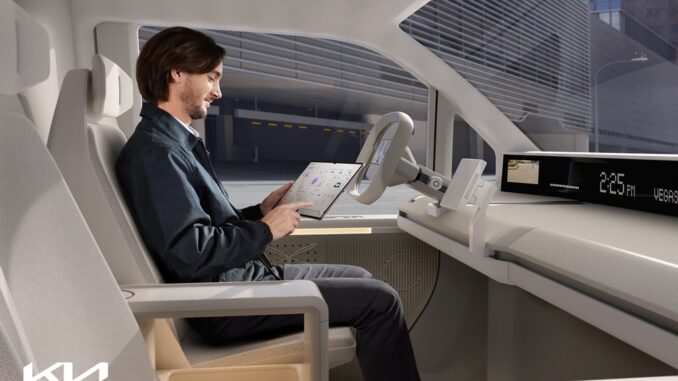
The launch of Kia’s PBV business will see the brand commit to providing a varied range of customised vehicle types to meet customers’ individual requirements.
Determined to overcome all existing restrictive and one-dimensional industry product line-up offerings, Kia believes its new approach to PBVs can help solve the mobility challenges encountered by individuals and organisations with limited transportation options.
Kia’s PBV offering is the embodiment of a genuine customer-centric approach and will be built around a dedicated business system, integrating vehicles, software, and future technologies to deliver added value.
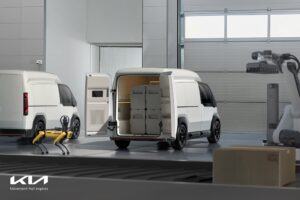 The brand’s PBV roadmap, divided into three distinct phases, illustrates how Kia PBVs will be pivotal in realising the Group’s SDx vision as devices that offer tailored solutions according to customer usage patterns.
The brand’s PBV roadmap, divided into three distinct phases, illustrates how Kia PBVs will be pivotal in realising the Group’s SDx vision as devices that offer tailored solutions according to customer usage patterns.
Phase one will see the introduction of the Kia PV5, a versatile EV optimised for major domains such as hailing, delivery and utilities that features conversion capability for diverse customer needs. Enhanced data connectivity between vehicles and external data such as route or delivery information will enable convenient operation of multiple vehicles as a software-defined fleet. This emergence of customised business fleets and PBV-specific solutions means less downtime and enhanced cost-effectiveness.
Phase two will see the completion of the dedicated PBV model line-up, and PBVs will evolve into AI-based mobility platforms that use data to interact with users and ensure that the vehicles are always up to date. An integrated PBV solution will provide a customised, seamless experience across devices and software. Meanwhile, new forms of business linked with robotics and other future technologies will emerge.
In phase three, Kia PBVs will evolve into highly customisable, bespoke mobility solutions by integrating with the future mobility ecosystem. This is where Kia PBVs will ultimately become life platforms that turn any inspiration into reality. Connected self-driving vehicles will be managed as part of a single smart city operating system. With the emergence of a hyper-connected world where people, PBVs and social infrastructure are seamlessly linked, we will open the door to completely new lifestyles by creating a robust PBV ecosystem based on the Hyundai Motor Group’s future technologies for autonomous driving, advanced air mobility, robotics, and the energy grid.
Designed to make users’ lives easier
Utilising ‘Easy Swap’ technology to flexibly address the diverse demands of customers, a single vehicle chassis can be used to fulfil multiple mobility needs. Behind a fixed cab, or ‘driver zone’, a variety of interchangeable upper bodies, or ‘life modules’, can be connected to the base vehicle via a hybrid electromagnetic and mechanical coupling technology, turning the PBV into a taxi during the day, to a delivery van at night, and a personal recreational vehicle on weekends.
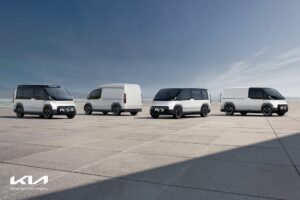 Modularisation is further made possible thanks to ‘Dynamic Hybrid’ weldless body structure assembly, which enables the length of moveable members to be flexibly adjusted according to vehicle use purpose. Comprised of high-strength tubular steel and engineered polymers, typical parts are reduced by 55 per cent with no loss in rigidity. Shipped in standardised, convenient kit form, Dynamic Hybrid technology will allow for the quick and simple in-field transformation of a Kia PV5.
Modularisation is further made possible thanks to ‘Dynamic Hybrid’ weldless body structure assembly, which enables the length of moveable members to be flexibly adjusted according to vehicle use purpose. Comprised of high-strength tubular steel and engineered polymers, typical parts are reduced by 55 per cent with no loss in rigidity. Shipped in standardised, convenient kit form, Dynamic Hybrid technology will allow for the quick and simple in-field transformation of a Kia PV5.
The design of Kia’s PBVs is inspired by robust, simple and clever tools and goes far beyond mere aesthetics. Kia’s primary mission is to ensure that the brand’s PBVs are simple and intuitive to operate and engage with, regardless of where, when or how they are used.
Whether the purpose of the vehicle is to transport people, move goods, or meet logistics or personal mobility needs, each PBV shares a consistent quality of design that reflects its solid, robust nature and projects a dependable and highly capable attitude. There are no unnecessary adornments, with each feature designed to serve a useful function which makes the lives of vehicle users easier, as clearly demonstrated by the concepts unveiled at CES.
A combination of a simple yet robust surface language combined with expressive graphics seamlessly unifies the PV5 models, despite their diverse natures. On each vehicle, large doors open out to reveal an exceptionally accommodating pillarless opening that provides effortless ingress and egress. Inside, the extended wheelbase and electric platform ensure wide, flat open spaces to offer near-endless stowage and usage possibilities. The driver’s experience is also enhanced, as the cockpit provides a desk-like surface, and the steering wheel can be folded to serve as a desk lamp, creating an office-like environment.
Sustainability sits at the core of Kia’s PBV design strategy. Extensive use of materials such as bio plastic, Post Consumer Material (PCM) plastic, bio paint, recycled PET fabric, felt and yarns, and bio-PU foam not only limits environmental impact today and tomorrow, but also delivers a unique visual and tactile appeal that leads to the creation of new aesthetic values.
Source: Kia Motors














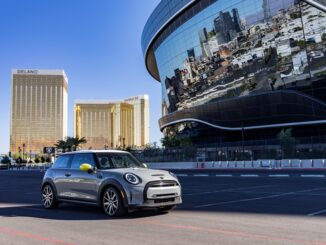
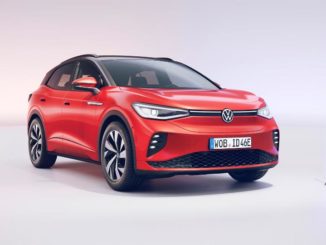
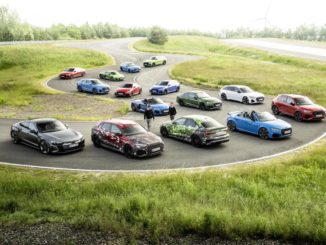
1 Trackback / Pingback